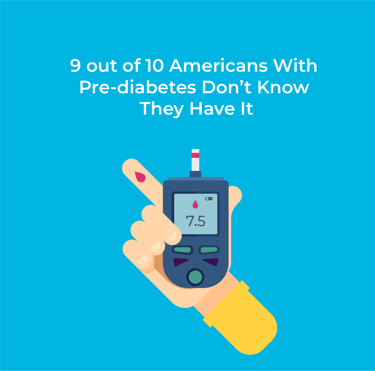 Unfortunately, diabetes is a growing issue in America.
Unfortunately, diabetes is a growing issue in America.
In our country, 30.3 million Americans are currently living with diabetes. To bring awareness to the seriousness of this disease, the American Diabetes Association established a single day in March to help the public understand the risk.
Enter American Diabetes Alert Day. This year it’s set for March 24.
Given that nine out of 10 individuals don’t know they have prediabetes, it’s a prime time to educate your employees. This day is the perfect chance to discuss what diabetes is and its lifestyle impacts.
Use this opportunity to educate your employees on diabetes, testing, dangers, complications, and treatments. It's tied to so many other issues — heart health, high blood pressure, vision loss, so it's a must that employees are aware of the consequences of it going unchecked.
Below, we share the facts so you can spread the word on a health issue that has a life-long impact.
Diabetes Types and Risk Factors
There are a few different types of diabetes people can be diagnosed with: Type 1, type 2, prediabetes, and gestational diabetes. Here we explain the difference of each:
Type 1 Diabetes
This type of diabetes is one that individuals are born with. It’s a chronic condition caused by the body attacking the pancreas so that it can’t create enough insulin. Without insulin, it causes sugar to build up in the bloodstream.
The exact cause is unknown, and type 1 can develop at any age. Diagnosis is most common among young children and preteens. A blood test determines if a person has type 1 diabetes.
Risk factors include:
- Family history
- Geography
- Genetics
- Age
Interesting to note: Some countries have higher rates of type 1 diabetes (examples are Finland and Sweden). Research shows cases of type 1 diabetes increase the further away individuals are from the equator.
Prediabetes and Type 2 Diabetes
Prediabetes may lead to type 2, but not everyone who has prediabetes will develop type 2. In both, the body’s cells become insulin resistant and the pancreas can’t make enough to move sugar into the cells and out of the bloodstream.
This causes excess sugar to stockpile in the bloodstream. The exact cause isn’t known for prediabetes, but there are more known risk factors than type 1, including some individuals have control over.
Risk factors include:
- Weight
- Inactivity
- Family history
- Race
- Aging
- History of gestational diabetes
- Polycystic ovary syndrome
- High blood pressure
- Abnormal cholesterol and triglyceride levels
These two health concerns may develop at any age, but physicians find it’s most common in those 40 and older. It’s important to note that while some individuals can easily control their blood sugar with exercise and diet, others may need to depend on insulin or medication to manage it.
Gestational Diabetes
Mid-pregnancy, gestational diabetes can pop up. Doctors usually test for it between 24 and 28 weeks of pregnancy. Luckily, it can often be controlled by eating healthy foods and regular exercise. In some cases, women may be required to take insulin.
Why it happens: The hormones created during pregnancy may make the cells more resistant to insulin and sometimes the pancreas can’t keep up. It’s possible for any woman to develop gestational diabetes during pregnancy.
Potential risk factors:
- Age 25 or older
- Family history of diabetes
- Have or had prediabetes
- History of gestational diabetes
- Prior delivery of a large baby
- Race
Important to note: This is a critical test that shouldn’t be skipped during pregnancy. It’s tested for and treated during pregnancy. Not treating can be dangerous for both the mother and baby.
General Symptoms of Diabetes
Each type of diabetes has different symptoms. Individuals with prediabetes and type 2 may not experience symptoms until the disease has progressed. Type 1 diabetic may have more severe symptoms that appear rapidly.
The general symptoms of diabetes include:
- Increased hunger
- Increased thirst
- Frequent urination
- Fatigue
- Unexplained weight loss
- Irritability
- Slow-healing sores
On top of scheduling regular doctor’s visits and getting bloodwork done, it’s important to be aware of your body. Track unusual symptoms for a period of time to give your doctor a good timeline. Above all, if you have certain risk factors — like a family history of diabetes — be sure to let your doctor know.
Diabetes Complications
Diabetes doesn’t just impact blood sugar. As it progresses or gets left untreated, the greater the risks of serious complications. Untreated diabetes can lead to being permanently disabled or death.
Due to the nature of the disease, diabetes greatly increases the risk of heart disease and strokes, along with other cardiovascular conditions.
Other complications of the disease may include:
- Neuropathy - This is nerve damage that causes tingling, numbness, burning or pain. It’s most commonly felt in the feet and legs.
- Kidney damage - This could lead to kidney failure or irreversible end-stage kidney disease.
- Vision problems - Issues like retinopathy, cataracts, and glaucoma are a problem for diabetics.
- Foot complications - Diabetics are more likely to develop serious infections on the feet, which may lead to amputations.
- Skin conditions - According to the Cleveland Clinic, skin issues are often the first indication of diabetes. This includes bacterial and fungal infections.
- Hearing impairment - Hearing problems are more common in people with diabetes.
- Alzheimer's disease - While the relationship is not known, type 2 diabetes may increase the risk of dementia and Alzheimer’s.
- Depression - Managing diabetes can be overwhelming. Because of this, depression is common for those dealing with the condition.
Testing and Treatment of Diabetes
Getting diagnosed with diabetes is an important first step in getting back in control of your health. It’s important to note that type 1 diabetes often presents symptoms that warn of the condition. However, other types may not.
If you do notice symptoms, talk to your doctor about your concerns.
Here are screening recommendations from the American Diabetes Association (ADA):
- Anyone with a body mass index greater than 25 - This is regardless of age and for those who have additional risk factors like high blood pressure, a sedentary lifestyle, a history of polycystic ovary syndrome, or heart disease.
- Prediabetic risk - You’ll want to get screened every year for diabetes.
- Individuals over age 45 - As you age, you’ll be advised to receive an initial blood sugar screening. If results are normal, expect to be screened every three years.
- Women with gestational diabetes - You should receive diabetes screenings every three years.
How is Diabetes Testing Done?
A simple test is done to diagnose diabetes. These tests include fasting sugar blood tests or with A1c blood tests (glycated hemoglobin tests). The fasting test is done after you’ve gone without food or drink for at least eight hours. A1c blood tests don’t require fasting.
IMPORTANT NOTE: Even if you’re showing zero symptoms, it’s a good idea to get tested if you have any of the above risk factors.
Diabetes Treatments
Due to the nature of diabetes, it’s not a disease that can be treated without the help of a physician. Not only will your primary doctor be able to help you get a proper diagnosis, but they’ll put together a diabetic care plan for you, too.
Depending on your symptoms, your care plan may also include a list of providers to help with other health conditions, such as a podiatrist, optometrist, nutritionist, and endocrinologist.
When you’re new to dealing with diabetes, one of the most important aspects of the condition is monitoring your blood sugar levels. This can be done with proper exercise, diet, and medication.
A few ways doctors recommend treating diabetes:
- All types: Healthy eating and exercise are a critical part of treating diabetes. Nutrition plays a large role in all types of diabetics. Find healthy recipes here.
- Type 1: These individuals will need to have insulin injections, check blood sugar levels regularly, and count carbs.
- Type 2: This is typically treated with healthy lifestyle changes. Individuals will also need to monitor blood sugar levels and may also need to add medications and/or insulin.
Spread the Word About All Diabetes Types
Given that diabetes is becoming more prevalent, it’s important for both employees and employers to become aware of the signs. For those struggling with the disease, it’s good to keep up on the research, too.
American Diabetes Association Diabetes Alert Day is a prime time to discuss the disease.
But it’s also a good time to review the importance of medical coverage with employees, too. Those who don’t have health insurance generally have 60% fewer doctor’s office visits, but they end up in the ER 168% more than people who have insurance.
On March 24, consider passing along this free diabetes risk test evaluation. It only takes 60 seconds and can help individuals find out if they may be at-risk for type 2 diabetes. For you, it takes less than that to forward this information and the test along.
The result? You may just give someone life-saving information.
How will your office promote American Diabetes Alert Day? Share in the comments below!



